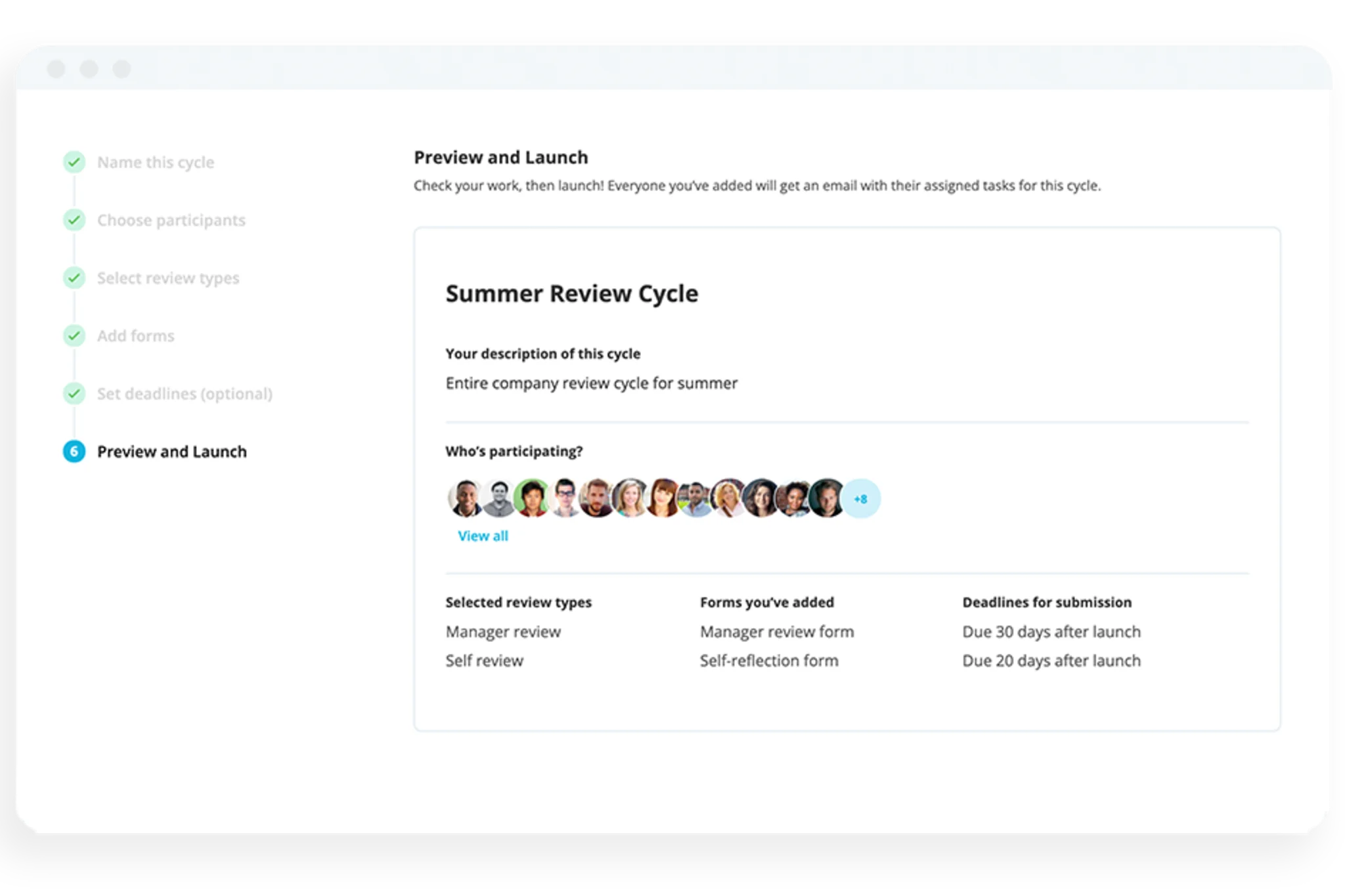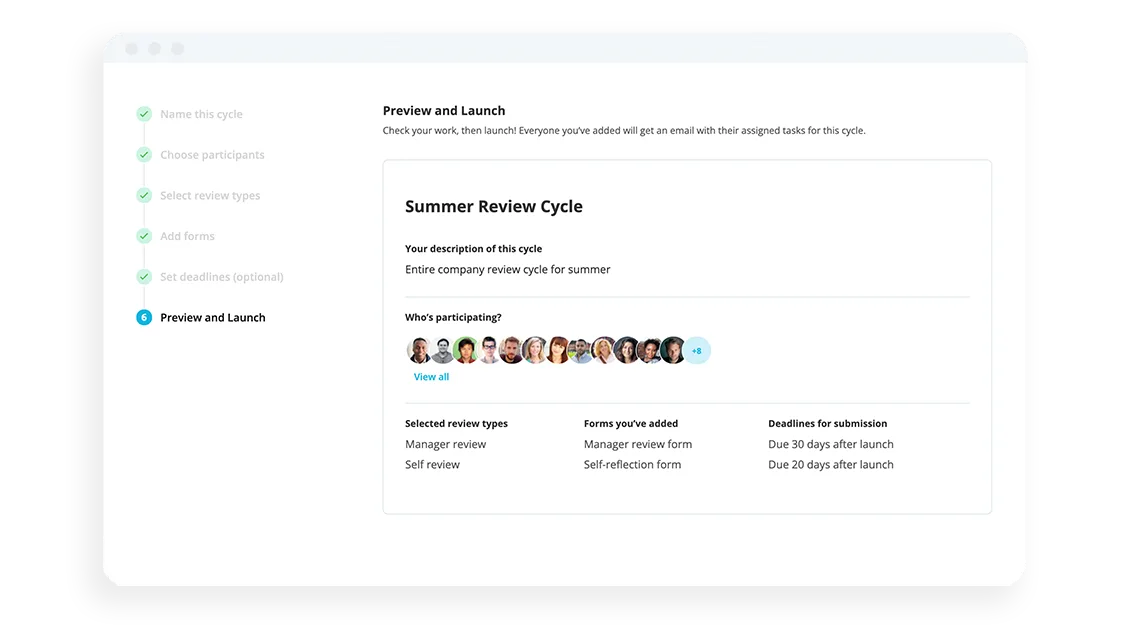How to Build a Professional Development Plan: Examples and Instructions

Putting together a professional development plan can completely change the way you nurture and retain your top talent. After all, goals only become reality when there’s a plan behind them.
Detailed plans are needed for most achievements in life. With careers, that’s definitely the case. Think of it as a roadmap that contains the milestones that employees need to hit in order to arrive at their destination. Follow these professional development plan examples to help teams build actionable plans today.
Contents
What is a Professional Development Plan
A professional development plan is a list of meaningful steps employees can take to reach their career goals. They are not just limited to high-level aspirations like joining the executive suite. They contain a detailed timeline of initiatives one can take to make it to that point. The plan should be a broader goal, with the smaller steps that you need to get there.
A timeline usually includes some combination of the following:
Education or training
Work experience
Promotions
Building professional relationships
A career development plan is a personal roadmap for employees. This plan may also overlap with one created during a company’s performance management cycle process. These cycles align performance goals with business goals, but are tied only to an employee’s work within the organisation.
A professional development plan, on the other hand, must not be confined simply to day-to-day work. It all depends on where employees see themselves in the future.
Parts of a Development Plan
A personal development plan for work can vary from organisation to organisation. Its customisation helps employees create and contextualise their development plans for any business operation. Despite their differences, most plans will have four sections in common:
Professional Goals and Aspirations. This section showcases the employees’ career goals and what they hope to achieve while working with their company. It’s vital for helping workers develop in ways that help them achieve their goals.
Strengths and Talents. This section will outline the competencies and knowledge the employee has already developed, creating a benchmark for how much they have left to learn.
Development Opportunities. Here, the manager or HR representative lists opportunities to get employees closer to their development goals.
Action Plans. This section is where the employee receives clear and achievable ways to reach the next step in their career. Typically, these are also tailored to help the employee gel better with their team.
Why Are Development Plans Important for Every Professional?
Development planning can benefit both your workforce and, in turn, your company in various ways. Generally, it plays a vital role in keeping your employees happy and productive and it enables them to remain better prepared for the future.
1. They Help Close Skill Gaps
One of the main purposes behind building an employee development plan is to identify their strengths and weaknesses. That way, employees can capitalise on their skills while taking steps to improve themselves by training to improve the competencies they lack.
2. They Increase Productivity
Because development plans teach workers new skills that make them more effective within their roles, they can also then use their time more effectively. An in-depth plan for improving themselves helps employees use their time more efficiently and accomplish more overall.
3. They Boost Employee Engagement
Offering a personalised development plan to employees makes them feel supported within the workplace. This provokes a greater drive to succeed as they feel more engaged with the company.
4. They Encourage Employees To Stay
Supporting an employee’s professional growth helps them feel more satisfied within their position, decreasing the chances of them moving on to another company. Staying with your company can improve their upward mobility while allowing you to retain top talent.
5. They Foster a Positive Company Culture
Employees tend to give back the attitude they receive. Having the support of their leadership helps to build a work environment centred around inclusion and collaboration.
How To Build Your Professional Development Plan
Some experts advise developing a professional development plan by listing each of their career goals. For many however, that’s a difficult task. Goals assume you know exactly where you are now and have a clear handle on your strengths, weaknesses and interests in order to focus on what’s next.
What if an employee needs help with their professional development plan? Here’s how to get the ball rolling:
1. Understand What They Really Want
You need to figure out more about your employees before you can best grasp how to help them grow. That means more than just asking about their goals; it’s understanding where they are at the current point in their career.
There are several ways that can help you learn about your team, for example:
Giving them self-assessments
Analysing their current job performance
Learning what aspects of their roles they enjoy the most
Figuring out what they’re most skilled at
Self-Assessment Tools
Start by suggesting a self-assessment test. This is useful if employees are at a crossroads in their career or if they just want to check in with themselves to validate their gut feelings about their current career path.
There are plenty of online assessment tools that measure interests, skills and ideal working styles and environments for employees. These include:
Set aside some time to do at least one or two tests and see what insights you can collect from an employee.
Analyse Current Performance
Take a closer look at what an employee does now and how well they do it. This will yield insights about strengths and interests that they might not have noticed before. This can take place in a performance review.
A performance review is best conducted by an employee scheduling a meeting with their manager to see how they are progressing in the role. Ideally, these meetings should be happening regularly anyway.
Together, they should look at the metrics used to evaluate success in their job and see where they stand. It’s useful here to cover questions such as:
How have they met or exceeded expectations?
How much value did they bring to the organisation during this period?
You can quickly see where an employee is pulling ahead and where they might need to focus more on trying to improve. It can also lead to a discussion on what they need to achieve in order to get to the next level.
Discover What Employees Enjoy Most
Along with evaluating their performance level in their current job, use that same opportunity to tease out which tasks they like most (and least). Start by having them look at their job description and list all the projects they have worked on recently, including smaller tasks. Look at their success metrics on these projects, too.
Then, mark those tasks they have enjoyed the most and those they found tedious or not valuable. This is another way to shed light on the direction in which goals should be moving. There are always tasks that an employee will like more or less than others, but by doing this exercise, you will hopefully spot patterns or at least bright spots that get the employee excited.
For instance, did they like doing analytical reporting during this period but didn’t like organising meetings? Then one of the goals in a professional development plan might be to take on more reporting projects.
Identify Top Skills
Take a look at the tasks an employee rated highly and make a list of the skills they used to complete them. This will help identify future projects where an employee can put those skills to use. It can even find areas for training in order to take those skills to the next level.
2. List Their Career Goals
Now that you know more about what your employee is good at and what they would like to pursue professionally, it’s time to formulate their goals. There are only two categories of goals to examine for this step:
Long-term goals. These are objectives your employee would like to achieve over the next several years.
Short-term goals. These are smaller goals that work as stepping stones for achieving larger ones.
Long-Term Goals
Looking further out, let’s say five to ten years, think about what an employee would like to achieve in the company or beyond it.
This long-term view should take into consideration the following items:
The position they would like to reach (through lateral moves or promotions)
Expertise that they need to have attained by that point
Other milestones that are important (for example, reaching a certain income level or being able to mentor high-potentials)
Short-Term Goals
Long-term goals require systematic work over time to reach them. Those actions become short-term goals. In other words, they are things that contribute to achieving the long-range goal, such as:
Acquiring skills or education
Building work experience to reach the next level
Working with and learning from certain leaders
For example, if an employee is an HR project manager now and their goal is to be an HR team lead within five years, a short-term goal may be to work toward a senior HR project manager position.
3. Identify Fillable Gaps
In this step, list the qualifications an employee needs to have in order to achieve each of their short-term goals. Then, help them determine where they fall short. These are the ‘gaps’ that they will need to fill.
There are two effective ways to identify the gaps in your employee’s skills:
Reading the description for a position they want
Performing a gap analysis
Read the Job Descriptions
Start by looking at the position description for the role that your employee wants to reach. Then compare the requirements of this role with their current one as a method of finding where they need improvement.
Using the example of the senior HR project manager above, you may see that it requires experience in developing top-level strategy and delivering presentations to the business leadership team. Now an employee has at least two areas where they need to develop skills in order to qualify for the job.
Perform a Gap Analysis
Doing a gap analysis also serves as a great place to start your focus. Let’s say an employee’s short-term goal is to achieve a certain position within two years, but the qualifications needed are beyond what can be managed in this time frame.
Alternatively, you may realise that the qualifications don’t fit well to the strengths identified in the first step. Both of these are signs that maybe this goal needs an adjustment.
4. Build a Proper Professional Development Plan
This is where it all comes together. An employee now knows their interests, goals and what stands between them and these goals. Together, you need to map out the various actions an employee can take to realise each of these goals in the allotted time frame. These could include:
Adding responsibilities to a current role
Completing formal education
Taking training courses inside or outside the organisation
Doing side projects to build skills
Developing informal and formal mentoring relationships
Getting coaching from a co-worker or team leader
Redesigning a current role to focus more on strengths
Two things are important here. The first is attaching a timeline to each of the activities in a plan. For example: ‘Complete project management certification by the end of the year’ makes this a time-bound action. You can help do this by planning backwards from the goal deadline.
The second is nailing down resources. As an HR professional, figure out how you can help facilitate the development of your employee. Can your team shift the workload around so that the employee can engage in more of the projects to help to develop their skills?
The ability to get support will have an impact on how an employee’s plan develops and whether it is successful, so it is imperative for HR to be involved from the beginning.
5. Help Monitor Progress
As with any plan, you will need to stay on top of it in order to see it come to fruition. Revisit the plan with employees often, especially if you need to involve others in the company for support. A good idea is to encourage employees to check in with their plans on a monthly basis. This affords the time to make changes, as needed.
Professional Development Plan: Example
Below is a personal professional development plan example to help you develop one for your employees. This template allows each section to be recontextualised for other professions. The example worker used here is a member of the sales team.
Professional Goals and Aspirations
After interviewing the sales professional, you find that this employee is interested in a leadership position within the marketing career path.
Strengths and Talents
In a self-assessment, you find that the employee has good communication skills and can work well as a part of a team.
Additionally, the employee has prior experience with marketing which is where they got this interest.
However, the employee’s marketing knowledge is somewhat outdated, and they have trouble thinking outside the box.
They also have very little experience in a supervisory role.
Development Opportunities
There’s an experienced project lead in the marketing department that’s open to a mentorship role.
A third-party organisation is offering on-site creativity workshops for all businesses within the area.
Set up an Action Plan for Your Employees
Over the next month: Shadow the project lead and ask questions about their role within the company.
Over the next three months: Attend the creativity workshops offered by the outside organisation.
Over the next year: Ask for more responsibility within your department to show you can handle more work.
Within the next three years: Apply for a managerial position within the company’s marketing department.
Frequently Asked Questions About Professional Development Plans
What Is a Professional Development Plan?
A professional development plan is a guide to help employees reach their career goals, often made collaboratively with their manager.
How Do You Write a Development Plan?
Writing a development plan tends to boil down to the following steps:
Learning and understanding an employee’s long-term career goals
Identifying the strengths that will help them achieve those goals
Finding opportunities to fill the skill gaps that will keep them from their goal
Developing a schedule for accomplishing tasks that will help them develop into better employees
What Is a Good Development Plan Example?
Goal: Earn a promotion within the marketing department.
Strengths and Weaknesses: You develop good communication skills but lack familiarity with social media communication.
Opportunities: There’s a social media marketing webinar being held for the next two weeks.
Action Plan: Within the next two weeks, attend a social media marketing webinar to improve your skills with social media channels.
Building Professional Development Plans Today
It might seem obvious to HR that employees need a professional development plan to reach their career goals. Yet, many people don’t invest time in creating an actionable plan, or they create one and neglect to monitor its progress. That’s understandable.
The process of crafting a professional development plan takes time. It’s an exercise in thought and digging deep to discover what you really want. But the payoff of one can be huge, both for the individual employee and the company.
Disclaimer
We would like to inform you that the contents of our website (including any legal contributions) are for non-binding informational purposes only and does not in any way constitute legal advice. The content of this information cannot and is not intended to replace individual and binding legal advice from e.g. a lawyer that addresses your specific situation. In this respect, all information provided is without guarantee of correctness, completeness and up-to-dateness.


